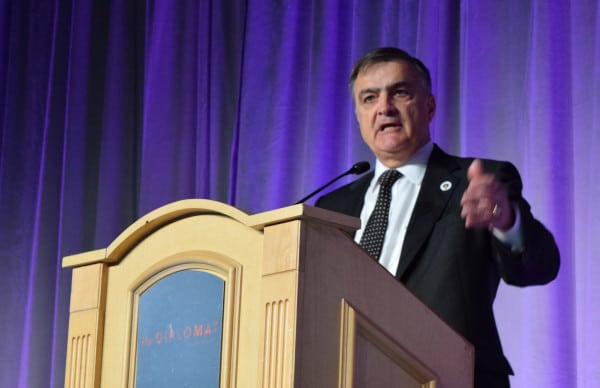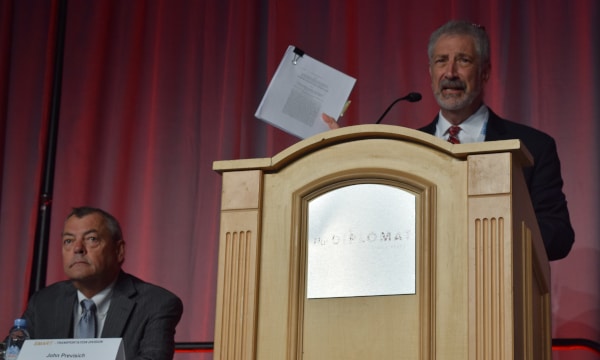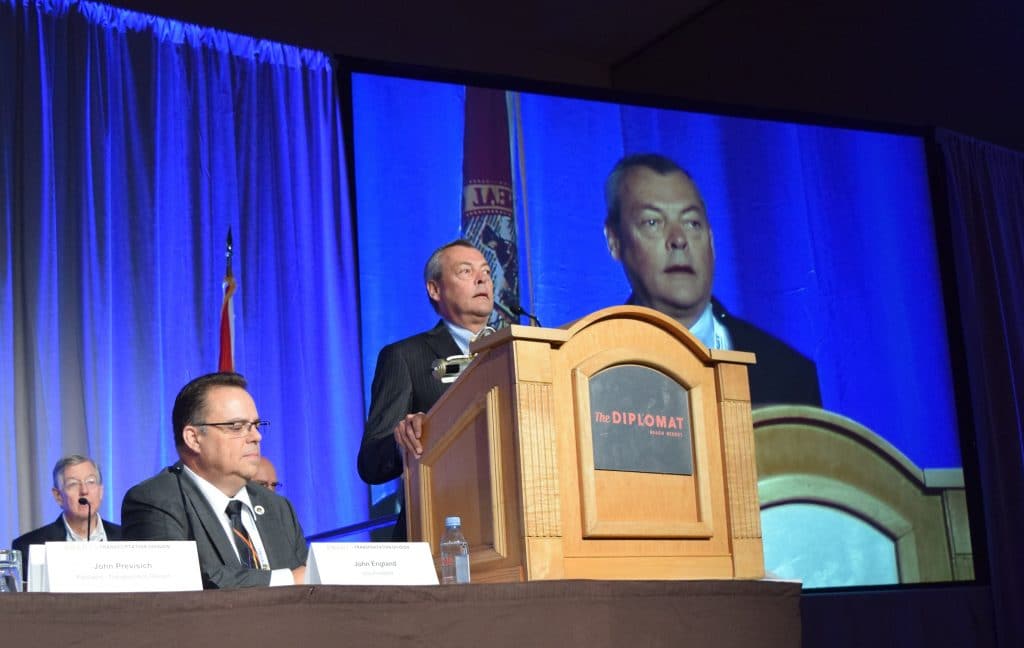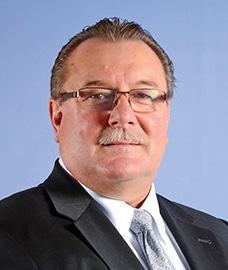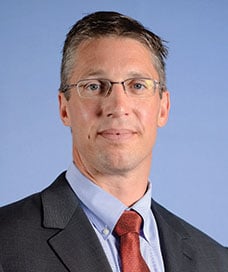HOLLYWOOD, Fla. — The results of Tuesday’s elections, while not the absolute best-case scenario for labor, indicated that voters might be ready to end the one-party majority in the federal government in three months’ time, said SMART Transportation Division National Legislative Director John Risch at the opening session of the last day of the 2018 Regional Meeting at the Hilton Diplomat Resort.
A special election campaign in Ohio saw both President Donald Trump and Vice President Mike Pence appear in support of Troy Balderson, who was running to finish out the remaining months of a term in Ohio’s 12th Congressional District. The seat was left vacated by fellow-Republican Pat Tiberia.
Yet even with the top two Republicans in the nation trying to give Balderson some momentum, he defeated Danny O’Connor, a relatively unknown Democrat, by 1 percent, according to unofficial results Tuesday. The 12th District, which includes Ohio’s capital Columbus, was carried by Trump by more than 11 points in the 2016 presidential election, according to The Associated Press.
Balderson and O’Connor will square off again in November for a full term to represent the district in Congress, and the result could be different with such a narrow margin.
Missouri’s special election Tuesday brought better news for labor, in what has been “a solidly red” state, Risch said.
Proposition A, a labor-led referral effort to repeal right-to-work legislation, was successful with 67 percent of voters voting to repeal a right-to-work law in place. Thirty-three percent of voters voted to keep the law, according to unofficial results. Labor faced much opposition with the Koch brothers leading an underground deceptive ‘yes vote’ effort that would have kept the right-to-work law in place. Missouri would’ve been the 28th state with such legislation in place had the referral not been successful.
“Even with all the deceptiveness, even with all the ways in which they tried to tilt the playing field in their favor – all of that, we won in Missouri,” Risch said.
He said a majority of voters in Missouri understood and recognized that Proposition A’s backers were trying to undermine the ability of unions to get better wages, fringe benefits and improve safety through deceptive direct mailings and other tactics.
“When they understand this, they vote the right way,” Risch said. “They vote for themselves, they vote for their unions, they vote for the ability to do something in the workplace.”
Risch feels that this victory, as well as victories by teachers in West Virginia, Arizona and Colorado this year, could signal a turning point for workers in the fight against income inequality.
“I see a trend, I see a movement across this country,” he said. “I think the tide is turning. I hope the tide is turning because we can’t go the other direction much longer.”
Author: bnagy
A monthly report from the Switching Operations Fatality Analysis (SOFA) Working Group reported six severe injuries to railroad workers during May 2018, including one amputation.
SOFA Working Group defines a severe injury as FRA-reportable injuries to train and engine service employees that have a clear and verifiable diagnosis and meet one or more of the following four criteria: (1) potentially life threatening; (2) high likelihood of permanent loss of function, permanent occupational limitation, or other permanent disability; (3) likely to result in significant work restrictions; or (4) result from a high energy impact to the human body.
The amputation to a leg or foot occurred in Missouri when a worker was trying to cross on a moving car and fell from it at an industrial location.
Four of the other five severe injuries reported by SOFA were fractures that came as a result of falls, while the fifth severe injury was a fracture that came as the result of an alleged assault by a passenger.
The SOFA Working Group is a voluntary, nonregulatory railroad safety partnership consisting of representatives from SMART Transportation Division, the Brotherhood of Locomotive Engineers and Trainmen (BLET), Federal Railroad Administration (FRA), Association of American Railroads (AAR) and the American Short Line and Regional Railroad Association (ASLRRA) that has a goal of zero switching fatalities achieved through education and nonpunitive interactions.
Read an earlier story about SOFA’s first quarter report and its 2017 annual report.
Visit our SOFA page and read SOFA’s full reports.
The U.S. Senate confirmed two members to the National Transportation Safety Board (NTSB) on July 24.
General aviation safety advocate Bruce Landsberg was confirmed as vice-chairman of the NTSB and transportation veteran Jennifer Homendy was confirmed to fill an empty board seat.
Homendy was nominated to the position in April and will fill a term lasting until Dec. 31, 2019, that was vacated by Mark Rosekind. She has served as Democratic staff director for the U.S. House Transportation and Infrastructure Committee’s railroad, pipelines and hazardous materials subcommittee since 2004.
Prior to that, Homendy was a legislative representative for the International Brotherhood of Teamsters and has worked for the Transportation Trades Department (TTD) , AFL-CIO, the American Iron and Steel Institute, and the National Federation of Independent Business.
“She will bring to her new role a deep understanding of the needs, responsibilities, and obstacles faced by America’s frontline transportation workforce,” said Larry I. Willis, president of the TTD. “On behalf of our 32 affiliated unions, I offer our collective congratulations to Jennifer for this important achievement in her career, and look forward to continuing our work together to enhance transportation safety.”
Landsberg held leadership roles in the Aircraft Owners and Pilots Association (AOPA) Foundation and Air Safety Institute for 22 years before his retirement from the organization in 2014. He has frequently worked with the Federal Aviation Administration (FAA) and other regulatory agencies, and industry groups such as the Experimental Aircraft Association (EAA) and the National Air Traffic Controllers Association (NATCA).
Landsberg was nominated to serve as NTSB vice chair in September 2017 and is slated to serve a two-year term as NTSB vice chairman, with his term as a board member extending through Dec. 31, 2022.
The success of an initial workers summit held in the spring is leading to a second meeting to be held Aug. 3, reports Terry Sigler, a retired legislative representative of SMART TD Local 286 in North Platte, Neb.
Sigler said an April 6 meeting he organized drew about 100 members from various unions to during two sessions at the North Platte Quality Inn and Suites, 2102 S Jeffers St.
The second summit is scheduled for 1 p.m. Aug. 3 at the same location. Members from all unions are invited.
Confirmed to attend is state Sen. Mike Groene (R – Dist. 41). Invitations also have been extended to state Sens. Tom Brewer (Dist. – 43) and Steve Erdman (Dist. – 47) and U.S. Rep. Adrian Smith. Groene and Brewer were sponsors of a two-person-crew bill in the Nebraska Legislature.
“This will be a great opportunity to talk directly with them as we prepare to submit another two-person-crew bill with these senators’ help,” Sigler said.
A pair of final regulations were issued by the Federal Transit Administration (FTA) in July that rounded out the National Public Transportation Safety Program’s regulatory framework.
The Public Transportation Agency Safety Plan rule, taking effect July 19, 2019, requires transit agencies to incorporate Safety Management System (SMS) policies and procedures in the development of safety plans. The rule sets scalable and flexible requirements for transit system safety plans by imposing the appropriate regulatory burden in achieving safety goals.
Compliance with the rule is required within a year, and FTA plans to offer guidance to assist large transit agencies in their development of safety plans and SMS implementation. FRA said application of the rule to small and/or rural transit systems will be deferred in order to evaluate the safety risks posed by these systems and to determine the need for future regulatory action.
The Public Transportation Safety Training Certification Program rule establishes a training curriculum for those who have safety oversight of rail transit systems. The rule goes into effect August 20, 2018.
“Through these rules, FTA will enter a new era of safety and we will continue to work with our state and industry partners to enhance public transit’s safety record,” acting FTA Administrator K. Jane Williams said in a July 18 release.
The authority for FTA to create a National Public Transportation Safety Program and to give it nationwide transit safety oversight was initially granted in 2012 by Congress and then enhanced by 2015’s FAST Act. Prior to that, FTA primarily was a grant-making agency.
For more information, read the FTA release on the rules.
